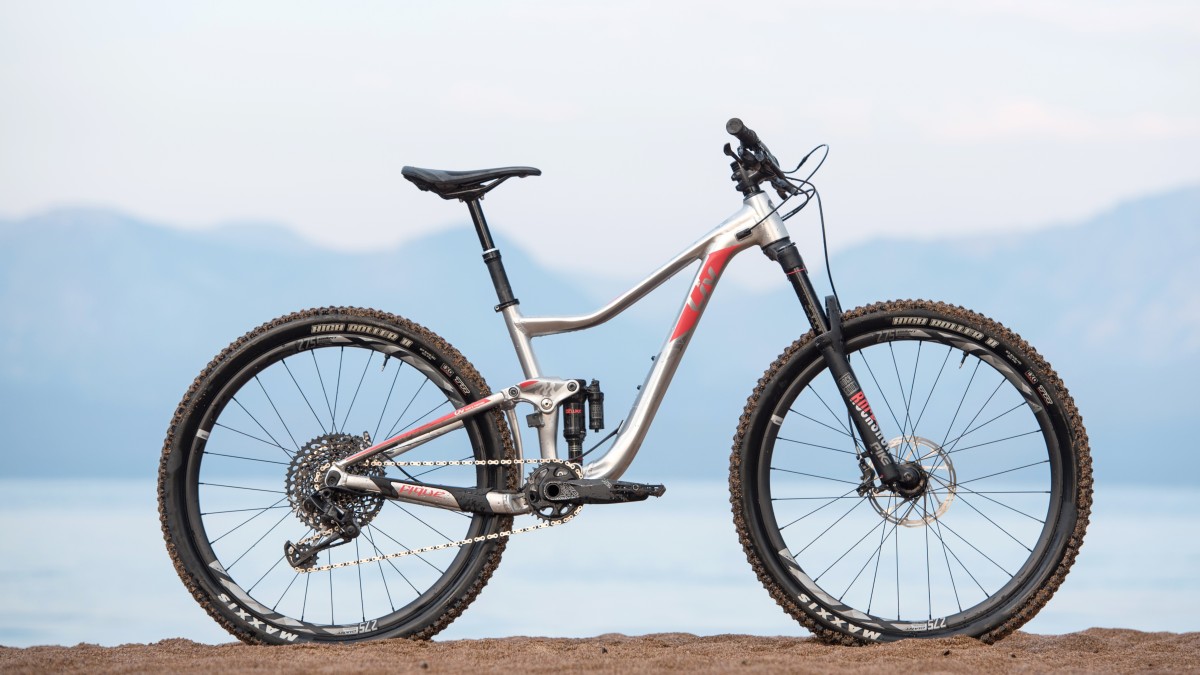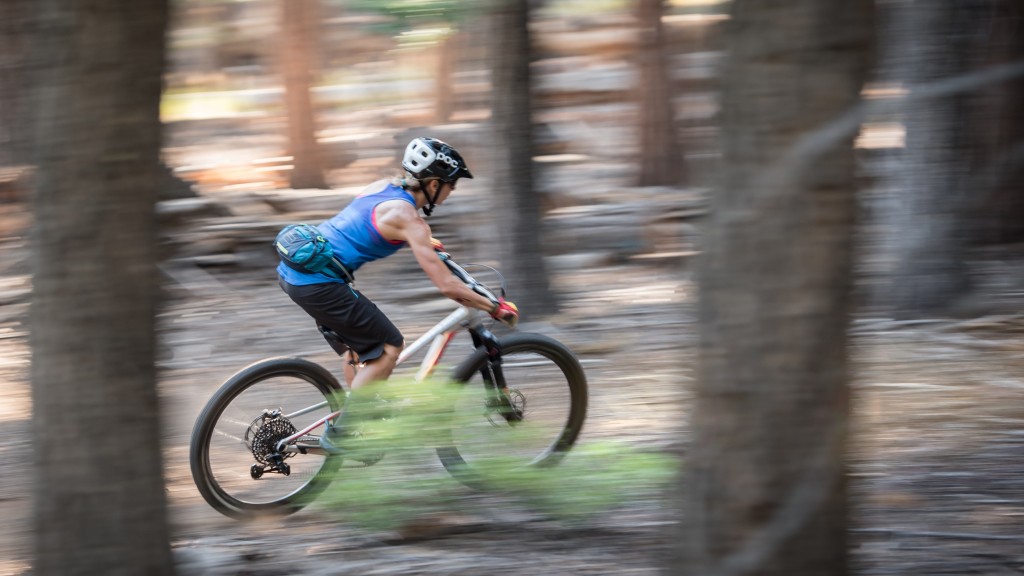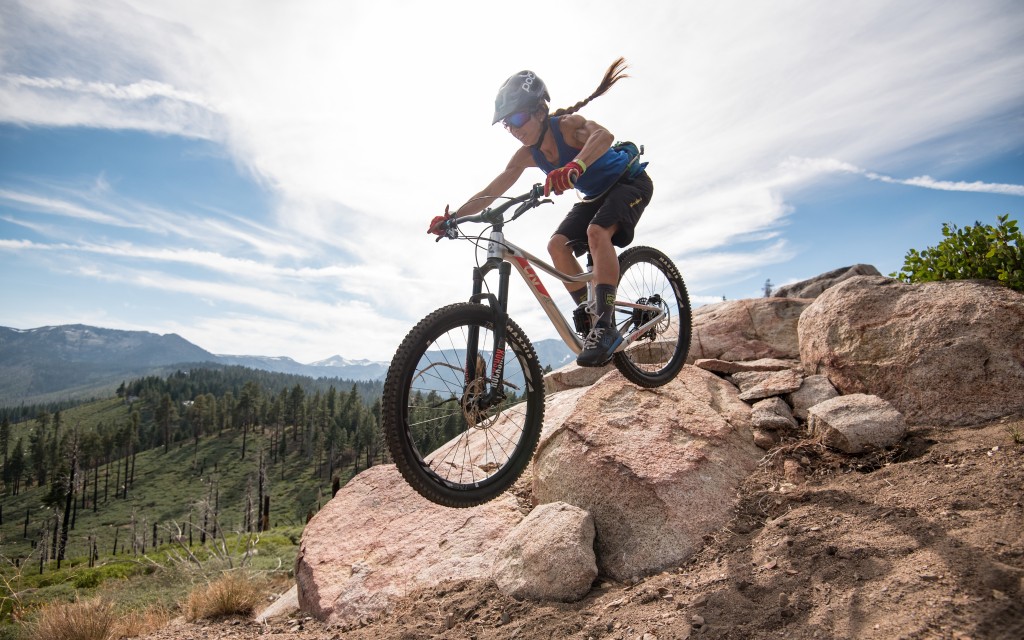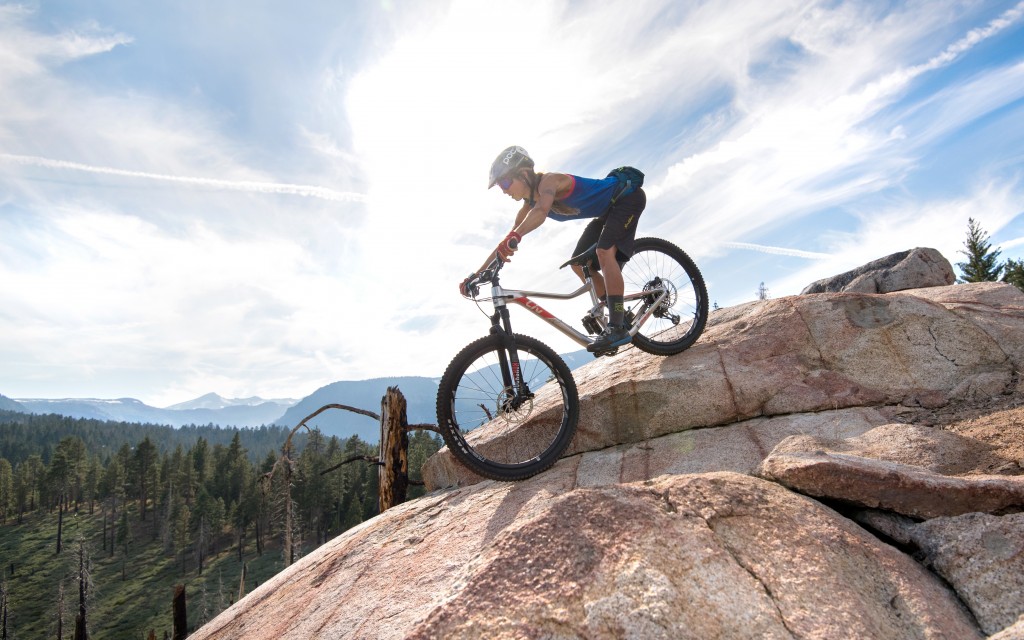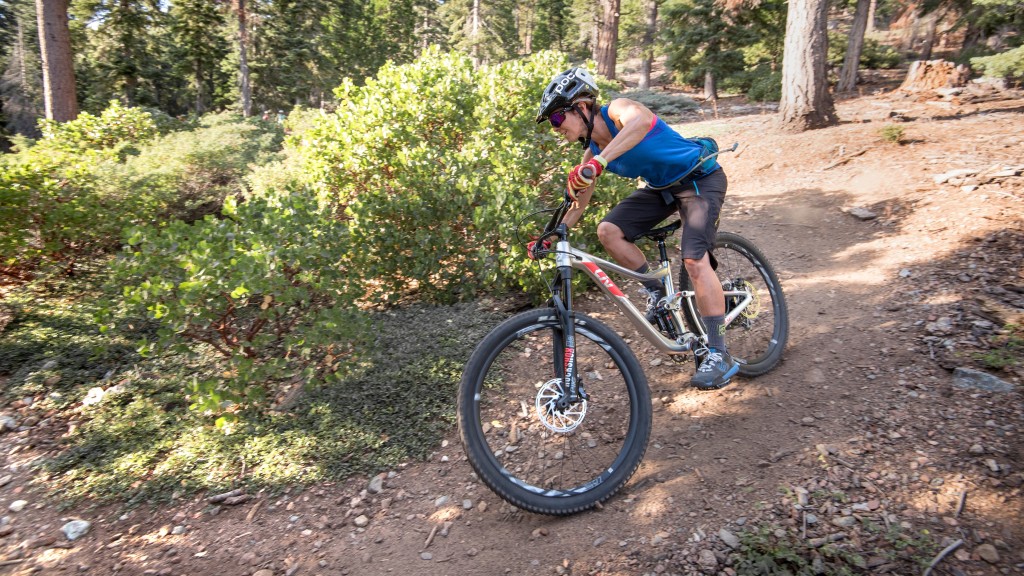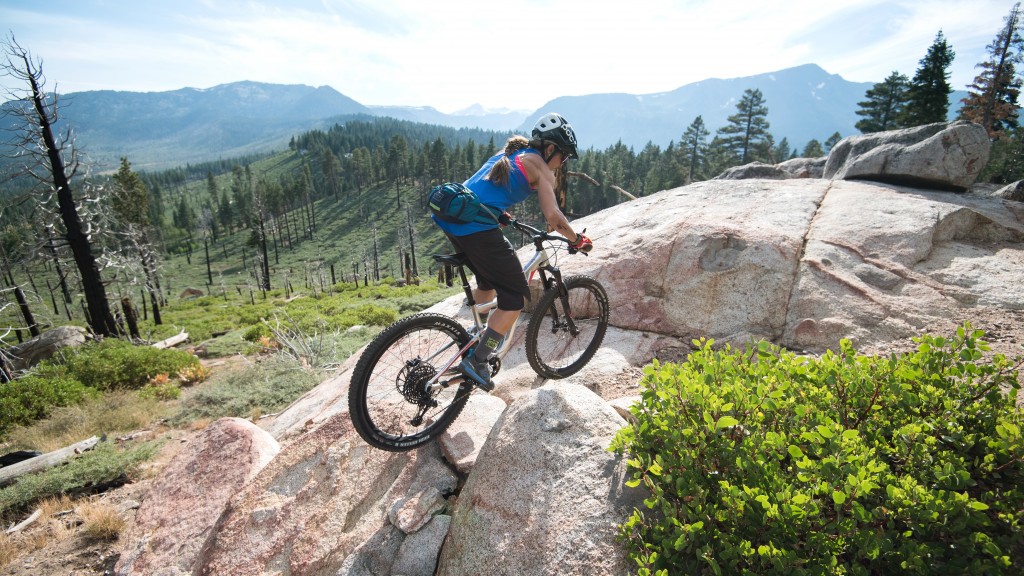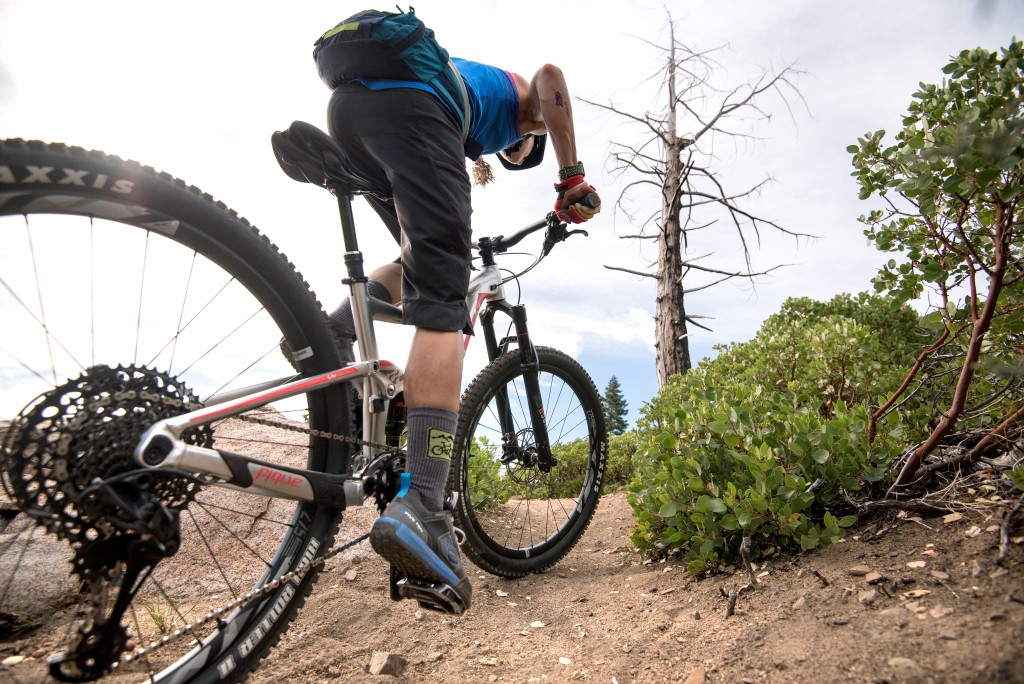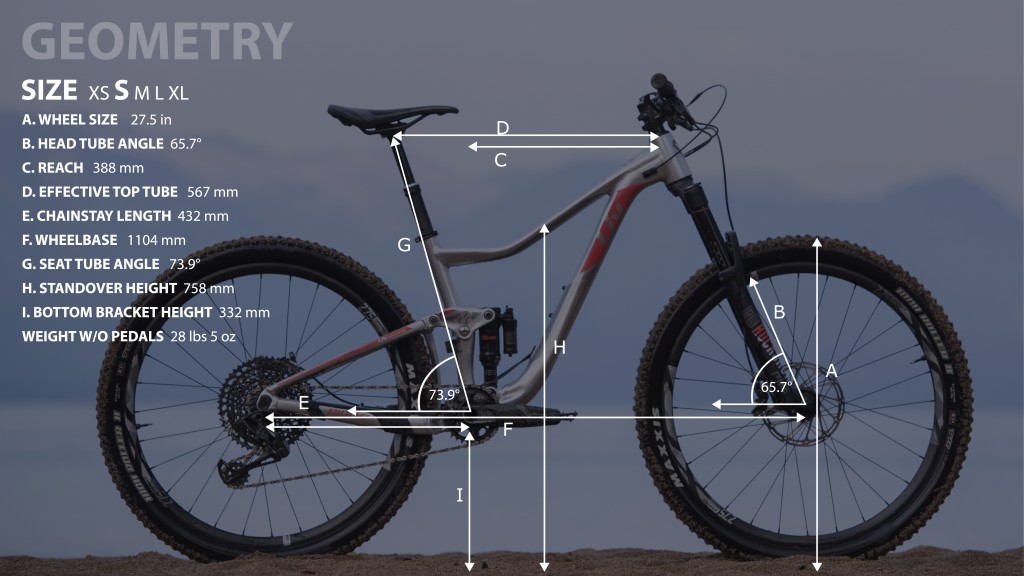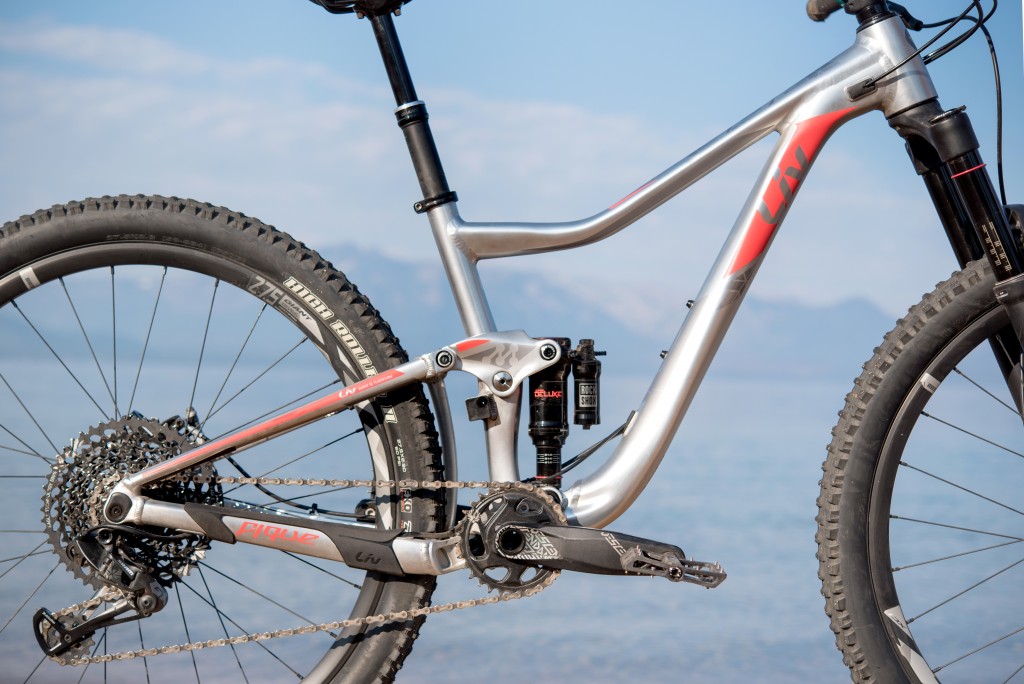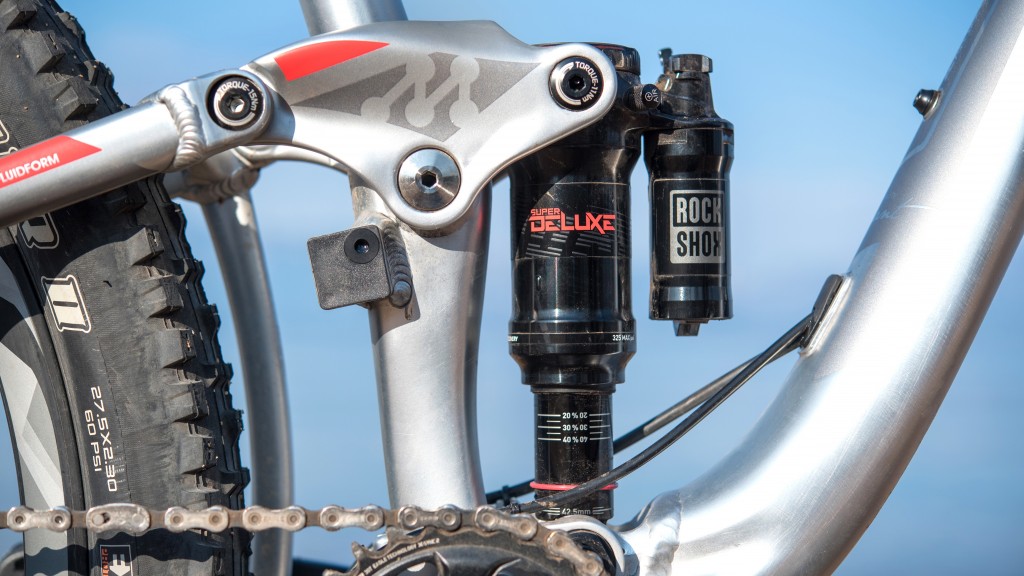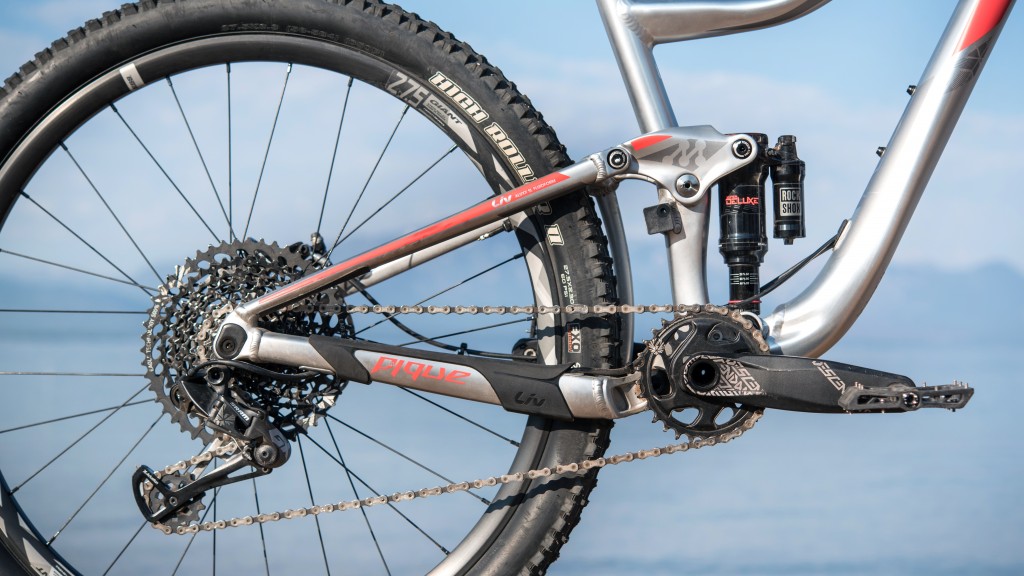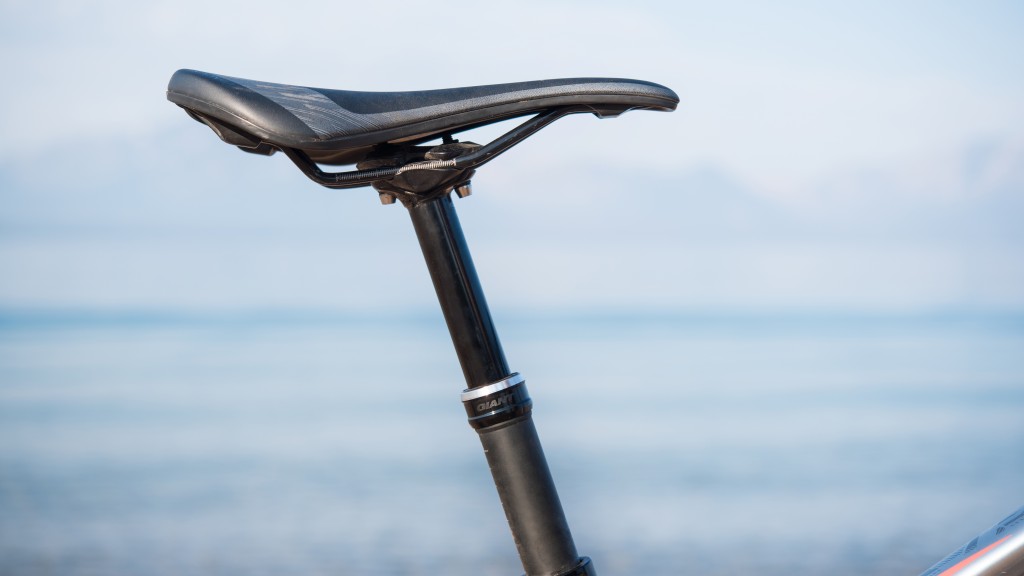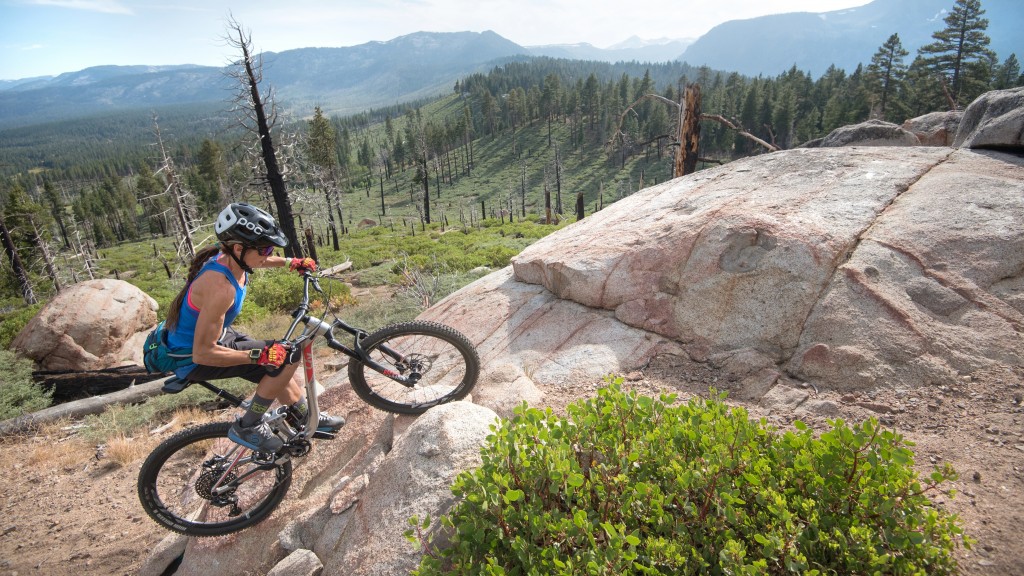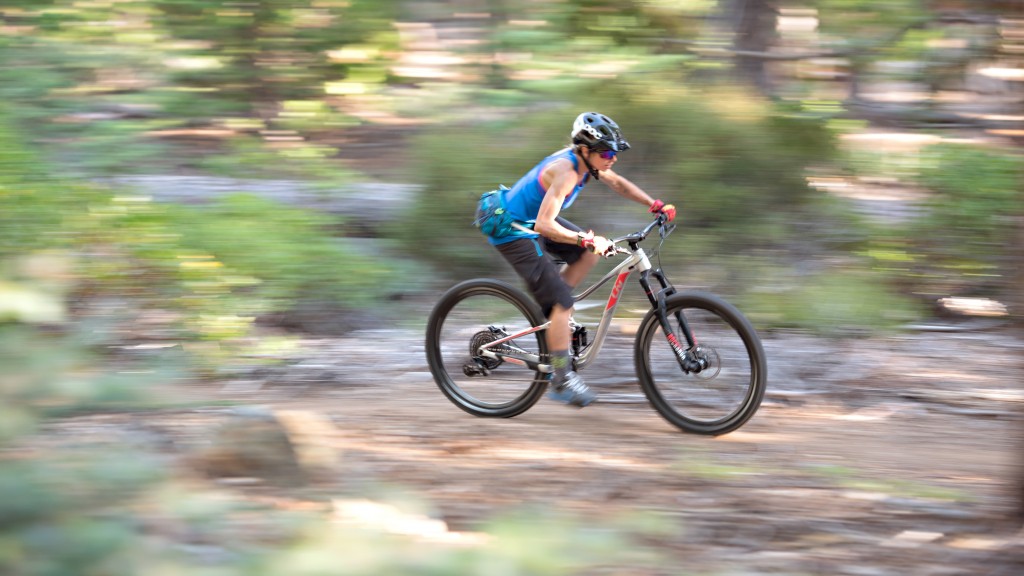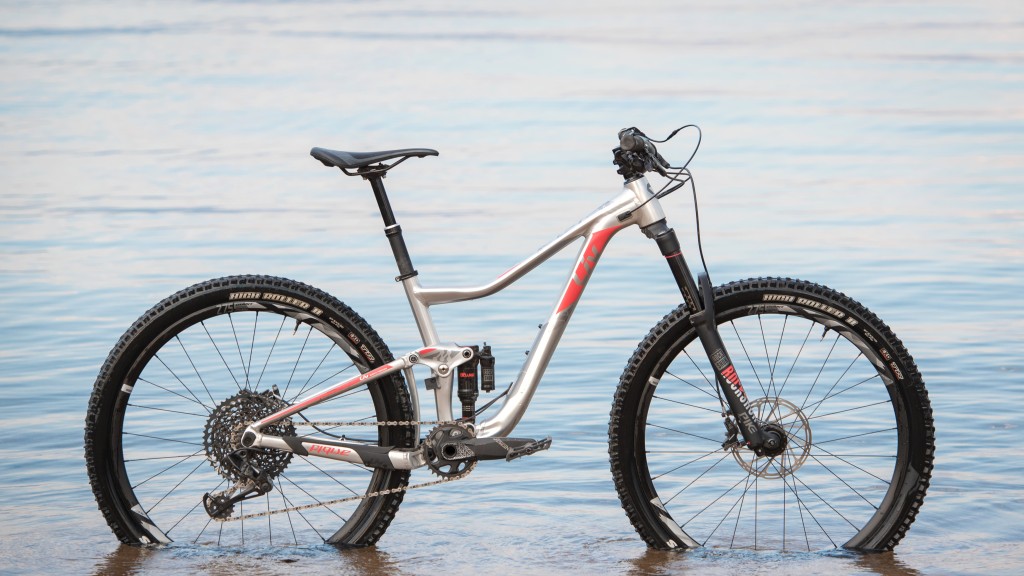This is a nice choice for a beginner or an intermediate rider who isn't interested in immediately pushing the speed limit on descents. Quickly rising RPMs can be hard to avoid as you improve. The Pique SX can handle it, but it takes an experienced rider to find the proper balance points, and it's tiring. None of this will help your confidence when you're pushing it like the well-rounded and more confidentJuliana Furtado will.
Liv Pique SX 1 2018 Review
Our Verdict
Our Analysis and Test Results
The Pique SX's frame has numbers that align fairly well with the rest of our women's test bikes. This is a shift from the 2017 version, called the Pique Advanced SX, which sported a steep, 69-degree head tube angle, shorter wheelbase and slightly shorter reach and top tube. Liv calls the 2018 Pique SX 1 more relaxed than the 2017 version. The slacker head tube angle, measured at 65.7-degrees and longer-travel, 140mm fork found on the 2018 Pique SX 1 are appreciated.
Fun Factor
The Pique SX is a competent and playful daily driver with easy-going climbing manners. This bike is no stranger to a good time. While it's fun to rip around your local rolling singletrack or fire road, the Pique requires deliberated and skilled positioning to work through rocky descents at speed. This narrows the range of fun that the Pique SX can provide.
At first glance, the women's specific Liv has a very comfortable cockpit. The reach and standover feel great for our 5'3" to 5'5" testers. This makes us think that attending to lighter riders with proportionally more leg than arm strength has merit in some situations. (Since innovation in bikes is going to continue, we might as well be working towards maximum results for all shapes, sizes, and types of riders.) Unfortunately, the Pique SX lacks the performance to back up its comfort.
There is some hard to articulate characteristic of the Liv's cockpit fit and overall geometry that feels magical on mellow terrain. The comfortable set up and light bike combine to make the Pique SX an energizing ride. When rolling along at moderate speeds, the Pique SX is zippy and playful. Descent hub engagement, clean shifting, and a 12-speed gear range provide on-demand acceleration and pretty much the perfect gear choice for any situation. The Pique SX is ridiculously easy to hop over obstacles or launch off rocks and practically begs to be tossed around. This is true even for our more conservative, intermediate tester.
While the Pique is easy to pop around, it doesn't feel solid enough to go all out in the air at high speeds. The same goes for aggressive handling at speed or on steeps. It doesn't have the balance and stability to back up its cheeky attitude. Riders are forced to work harder to maintain balance over the bike. It's easy to lose proper positioning and get shaken. As a result, you stop playing and start paying attention.
We ranked the Pique SX an 8 out of 10 for its lively attitude, killer climbing skills, and downhill limits. The more competent and similarly playful Juliana Furtado earned a 9 and the Specialized Women's Camber rated at 5.
Downhill Performance
The Pique SX is a sharp handler with the plushest rear end in the test. This is quite the accomplishment for a 120mm bike in Liv's cross-country category squaring off against the 130mm Furtado, categorized as a trail bike. Unfortunately, the bike's cockpit positioning makes it difficult to properly balance over the bike, especially when heading downhill with speed, requiring focus and skill. Under the guidance of an experienced rider, the Pique SX handles well under pressure, to a point. It just isn't as straightforward or confidence inspiring as the Juliana Furtado.
The Liv Pique SX sets you up in an upright, cross-country position. This was the most comfortable cockpit in the test for two of our four testers, in the parking lot and on mellow trails. However, this same positioning is odd when descending, forcing you to consciously move into the attack position instead of simply putting you there. The reach is by far the shortest in the test at 388mm. The Specialized Camber's comes in at 401mm and the Juliana Furtado's 408mm. This is despite a top tube measurement that falls in the middle of the pack. As we mentioned in the frame design section, this is because the bottom bracket is pulled further forward in the frame than the other two bikes.
As a result, when you stand up, you are further over the front wheel than you'd like to be. It's hard to keep your weight off the fork and allow it to float over obstacles. You have to find your way off the back of the bike and stay nice and low to get the geometry to work. It's not an extreme move, but it is a very deliberate one. The steeper and more technical the trail the more you have to shift back. This can be tiring. It's also a bit precarious, forcing you to move around constantly, seeking proper balance.
That is the rub of women's specific bikes that buck the current industry trends of longer/lower/slacker. They give women — and their presumably shorter torsos, longer legs and lower centers of gravity — shorter reaches and top tubes and higher bottom brackets to keep us from straining our necks and backs and to avoid pedal strikes. This makes us work harder to get into an aggressive descending position and comes at the cost of some downhill performance.
If you can nail the positioning, the Pique SX feels awesome. Several of our testers were skeptical of this bike's downhill skills, and all were pleasantly surprised. When you're balanced and flying downhill, the Pique's rear suspension handles the trail with grace. It just floats over the obstacles. The RockShox Super Deluxe RCT rear shock and Pike fork open up nicely for smaller bumps and ramp up confidently on bigger hits. Again, higher speeds and more technical terrain start feeling skittish, and our testers find themselves reeling it in regularly aboard this bike.
Though the rear suspension is the cushiest in the test, it produces a pronounced sensation of very vertical travel. Giant and Liv market their shared Maestro suspension as having a near vertical wheel path, which could be the explanation. The bike seems to sink straight down into its suspension, in contrast to more aggressively angled bikes which catch you while maintaining the feeling of forward momentum. As a result, the Pique SX can feel incongruent at times on more aggressive downhill rides.
The Pique SX is at its best on rolling descents where body positioning isn't as important. Here it is playful and feels great to pedal, offering maximum power out of every stroke. Handling is responsive and pumping into berms is a blast. We could do with a more aggressive tread than those Maxxis High Rollers provide.
Climbing Performance
Between the lovely drivetrain, the light feel, and forward positioning the Pique SX climbs nicely. Here the compact and upright cockpit works surprisingly well, making it easy to get out of the saddle and to power through the steeps. When standing, you are very far over the front wheel. When seated, the forward positioning of the bottom bracket can feel odd at times. Performance didn't suffer, however, and we adjusted to the different feel quickly. However, on longer climbs, the constrained positioning can feel cramped.
In technical stretches, the front end is easy to wheelie over obstacles. It also handles hits well without deflecting or stuffing into its travel. The frame and handlebars don't feel as pleasantly stiff and robust as the carbon Juliana Furtado when yarding on them, but it works. At times, the Pique's front can feel a little too light and can drift up on you. It's infrequent and easy to shift forward to drop the front wheel back down.
The SRAM GX Eagle 12-speed drivetrain helps you find the sweet spot for every section of trail. It offers up the perfect gear for every occasion and will have you heading uphill on even your laziest days thanks to that wonderful 50-tooth cog. It doesn't feel faster than the other bikes, often because easier spinning means slower speeds. It saves on effort, offering the least painful climbing in the test. Speedy hub engagement and a solid feeling pedal platform complete the efficient experience. Evey pedal stroke gives the impression of added power. The Pique SX's higher bottom bracket makes it unlikely to pedal strike, but we didn't find ourselves striking much on any of the bikes.
The Pique SX was the slowest climber in our benchmarking time trials, likely because of the relaxing 50-tooth offered by the SRAM GX Eagle. The stiff-geared Furtado won the test but might be more tiring over time than the Pique.
Frame Design and Suspension Overview
Liv uses Giant's technology and manufacturing power and features the same Maestro Suspension system. The Maestro design is very similar to the DW-Link system used by Ibis and Pivot. Giant claims that its two linkages and four pivot points focus rotation around a single floating pivot point near the center of the rear triangle. According to Giant, this creates a vertical wheel path that is reactive to big and small hits without squatting under pedal or braking pressures. We found the Maestro Suspension on the well-liked unisex 2017 Giant Anthem supple, efficient and dependable. The Pique SX's 120mm of suspension offers efficient pedaling and is quite plush. However, we do get the feeling of sinking straight down into the suspension, like an office chair, rather than the simply having a smooth landing that better aligns with the angle of the trail.
The 2018 Pique SX 1's aluminum frame offers a better trail feel but less stiffness than the carbon Juliana Furtado. It is also less likely to suffer cracks and dings that demand frame replacement on a carbon fiber bike.
We measured the effective top tube at 567mm and the reach at 388mm, that's a short reach for a moderate sized top tube. The bottom bracket is pushed further forward between the two axles than any other bike in the test. The distance between the center of the bottom bracket and the center of the front axle is only 689mm (the front center measurement) compared to the 699mm on the Juliana Furtado. This bottom bracket positioning also allows the bike to have the longest chainstays in the test at 432mm but still keep a compact wheelbase at 1104mm. These numbers combine with a 73.9-degree seat tube angle to make for a comfortable but upright cockpit. Riders are placed in an oddly forward position when standing, keeping the bike from feeling very aggressive on descents. A 332mm high bottom bracket is the highest in the test. This is detrimental to providing a planted and stable feel. Weighing in at 28 pounds, 5 ounces, this metal bike is the lightest in the test.
Build
Though the Pique SX 1's frame and suspension design don't match the sturdy performance offered by the Juliana Furtado's frame, we are very impressed with the excellent build kit on this bike.
Fork and Shock — The 140mm RockShox Pike RC Solo Air is a superior fork that leaves little room for improvement. The RockShox Super Deluxe RCT is the only rear shock in the test with a high-speed compression adjust and it offers a highly adjustable and plush ride. The upright placement of the shock makes it difficult to clean the shock stanchion or bolts regularly or well. The rebound adjustment at the top is tough to grip to adjust it. It's not impossible, but it is annoying.
Wheels and Tires — The 23mm inner width Giant XC-1 Disc rims are much narrower than we prefer in 2017, the year of 30mm rims. More traction is always appreciated and could help ground this flighty feeling bike. The engagement on the Giant Performance Tracker 28 hole hubs could be better.
Maxxis High Rollers can be a little funky in the corners, and our larger, unisex testers (140 to 190 pounds) don't adore them as a general rule, but they work fine in this application. We did appreciate the 2.4-inch width up front, and the 2.3-inch in the rear helped the High Rollers hold on in the rocks and roots.
Groupset — The SRAM GX Eagle 12-speed drivetrain is an excellent spec on this bike. It provides a bailout, I'm tired, climbing gear and an excellent range of sweet-spot mid-range gears to comfortably pedal without having to over-power up climbs. Shifting is nice and crisp.
The SRAM Guide RS brakes are a welcome step up from the Level T's spec'ed on the Juliana and the Specialized. The Level T's are lighter and designed for lighter use. We like the power of the Guides and the adjustability the mid-level RS provides.
Handlebars, Seat, and Seatpost — The Giant Contact Trail 750mm handlebars are comfortably wide, providing stability for handling without having to worry about them through tight trees. Most of our testers would prefer wider bars however. The 31.8mm diameter works fine but isn't nearly as bad-momma feeling as the 35mm bar on the Juliana Furtado.
The Liv Contact Forward saddle isn't cause for complaint. The Giant Contact S Switch-R Trail seatpost worked reliably. The 100mm of travel is a little short, however. We have a substantial amount of exposed post to get the saddle to proper pedaling height. This limits the utility of the dropper.
Out of 10 possible points, we ranked the Pique SX 1's build at a 10. As you can see in the graph above, it bested the more modest build kits on both the Juliana Furtado R and the Specialized Camber Comp.
Build Options
Liv doesn't offer any other build options on the 2018 Pique SX other than the 1 we tested. The 2018 Pique Advanced and 2018 Pique share a frame, which differs from the 2018 Pique SX we tested. The Pique SX has a slacker head tube angle, by 3-degrees, and a slightly slacker seat tube angle, longer top tube, shorter reach, and longer wheelbase. Both the Pique Advanced and Pique have 130mm of travel up front to the Pique SX's 140mm. All of this makes the SX more downhill friendly while the other bikes in the Pique line favor the climb and fall in line with more cross-country style riding.
The 2018 Pique line offers more basic complete bike builds, running $2,200 for the Shimano Deore powered Pique 3 with a RockShox Recon Gold fork and Deluxe R rear shock. The Pique 2 gets a Shimano SLX drivetrain and Fox 34 Rhythm fork and Float Performance rear shock. The Pique Advanced 2 buys you Shimano SLX, a RockShox Revelation RC fork and Deluxe RT rear shock for $4,000. The Advanced 0 goes big with a SRAM X01 Eagle 12-speed drivetrain, RockShox Pike RCT2 fork, and Super Deluxe RCT rear shock.
Brand Background
Liv is a fully women's brand, according to a conversation we had with Liv US Marketing Manager, Jen Audia. That is, the engineers and designers who create these bikes for women, are women. According to Audia and the Liv website, bike geometry is based on average female body dimensions from a global body dimension database and feedback from testers. Liv bikes are meant to account for women's proportionally longer legs, shorter torsos, and higher leg to arm strength ratio on average when compared to men, who made up the majority of mountain bike consumers in the past. According to Audia, this means that the average woman's balance and leverage points on a bike are different than the average man's.
The theory is that a woman is stretched out too far on frames build for longer torsoed men, making it harder for her to pull up on and toss around the front end. Liv's geometry aims to create bikes that address these differences. They don't want women to have to make a lot of changes out of the box for the bike to work for them, including touch points like women's saddles, grips, and shorter cranks.
In contrast, competing women's brand Juliana points out that the Center for Disease Control and Prevention (CDC) has shown no discernible body dimension differences between men and women, so they just make bikes in a bunch of sizes. Liv's Audia thinks this difference of opinion is just fine. Each company has a different focus, and there are lots of ways to make a bike. This is Liv's.
Aside from just making women's bikes, Liv wants to widen the riding community. They want women to look at a bike shop or local trail and say, in Audia's words, “This is my treehouse.”
But, while the industry is moving to longer top tubes, shorter chainstays and slacker head tube angles to improve stability and confidence on descents, Liv is holding onto what looks like regressive, upright geometry in the name of suiting women's bodies. They don't seem to be taking into account what women want to do with those bodies. Liv's most aggressive trail bike, the Hail has a higher bottom bracket and steeper head tube angle than it's brother bike, the Giant Reign. We don't know any women riding enduro that are looking for old-school geometry options that hurt performance.
We came into this testing thinking that we might be able to say something about whether or not women's specific geometry is pure hype or if there is something more substantive to it. The lesson we learned, yet again, is that sweeping generalizations just don't work that well. Some things work great aboard the Liv Piques SX — some don't. So we'll just keep taking it bike by bike.
Value
Not exactly a steal at $3,700, the Liv Pique SX 1 features an excellent build spec that leaves very little to be desired at this price point. If you're looking to progress to more technical trails, however, you may end up needed to get a higher performance frame sooner than you'd like.
Suggested Upgrades — Wider rims would be nice. That's about it.
Conclusion
The well-equipped Liv Pique SX offers excellent climbing and a high fun factor on mellow rides. This bike is a solid option for riders who know themselves well and never suspect that they will want a bike that they can push too hard downhill.


